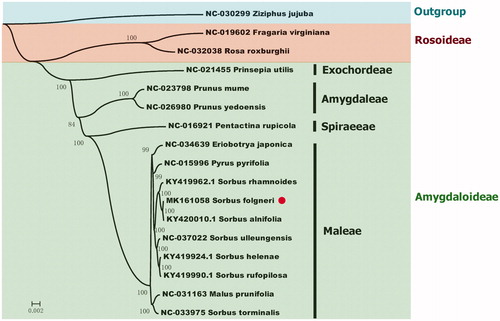Abstract
Sorbus folgneri (C.K.Schneid.) Rehder is widely distributed tree species across China which can be used as medicine, building materials and ornamental plants. In this study, the complete chloroplast (cp) genome sequence of S. folgneri was determined using next-generation sequencing. The entire cp genome was determined to be 163,464 bp in length. It contained large single-copy (LSC) and small single-copy (SSC) regions of 86,721 and 17,961 bp, respectively, which were separated by a pair of 29,391bp inverted repeat (IR) regions. The genome contained 133 genes, including 88 protein-coding genes, 37 tRNA genes, and eight rRNA genes. The overall GC content of the genome is 36.4%. A phylogenetic tree reconstructed by 17 chloroplast genomes reveals that S. folgneri is most related with Sorbus alnifolia.
The genus Sorbus L. comprises approximately 80 species and occurs widely throughout northern hemisphere (Lu and Spongberg Citation2003). There are about 50 species of Sorbus in China. Sorbus folgneri (C.K.Schneid.) Rehder is widely distributed across central and southern China which can be used as medicine, building materials, and ornamental plants. In addition, its phylogenetic position is unclear in previous studies because of the lack of genomic resources of genus Sorbus. Here, we characterized the complete chloroplast (cp) genome sequence of S. folgneri, the third complete plastome sequence from the genus Sorbus, based on the genome skimming sequencing data.
The total genomic DNA was extracted from the fresh leaves of S. folgneri (Lushan National Park, 29.32°N, 116.01°E) using the DNeasy Plant Mini Kit (Qiagen, Valencia, CA). The DNA was is stored at −80 °C in our lab. The whole genome sequencing was conducted by Nanjing Genepioneer Biotechnologies Inc. (Nanjing, China) on the Illumina Hiseq platform. The filtered sequences were assembled using the program SPAdes assembler 3.10.0 (Bankevich et al. Citation2012). Annotation was performed using the DOGMA (Wyman et al. Citation2004) and BLAST searches. The plastome of S. folgneri was determined to comprise double-stranded, circular DNA of 163,464 bp containing two inverted repeat (IR) regions of 29,391 bp each, separated by large single-copy (LSC) and small single-copy (SSC) regions of 86,721 and 17,961 bp, respectively (NCBI acc. no. MK161058). The genome contained 133 genes, including 88 protein-coding genes, 37 tRNA genes, and eight rRNA genes. Eight full protein-coding genes, seven tRNA genes, and four rRNA genes were duplicated in IR region. Nineteen genes contained one intron and two genes (clpP and ycf3) contained two introns. The overall GC content of S. folgneri cp genome is 36.4% and the corresponding values in LSC, SSC, and IR regions are 34.2%, 30.3%, and 41.5%, respectively.
To investigate its taxonomic status, Alignment was performed on the 17 chloroplast genome (16 Rosaceae chloroplast genomes and the outgroup Ziziphus jujube) sequences using MAFFT v7.307 (Katoh and Standley Citation2013), and a maximum likelihood (ML) was constructed by FastTree version 2.1.10 (Price et al. Citation2010). The ML phylogenetic tree shows that S. folgneri is most related to Sorbus alnifolia in Maleae, with bootstrap support values of 100% ().
Disclosure statement
No potential conflict of interest was reported by the authors.
Additional information
Funding
References
- Bankevich A, Nurk S, Antipov D, Gurevich AA, Dvorkin M, Kulikov AS, Lesin VM, Nikolenko SI, Pham S, Prjibelski AD, et al. 2012. SPAdes: a new genome assembly algorithm and its applications to single-cell sequencing. J Comput Biol. 19:455–477.
- Katoh K, Standley DM. 2013. MAFFT multiple sequence alignment software version 7: improvements in performance and usability. Mol Biol Evol. 30:772–780.
- Lu L, Spongberg SA. 2003. Sorbus L. In: Wu Z, Raven PH, editors. Flora of China: Pittosporaceae through Connaraceae. Vol. 9. Beijing (China): Science Press; St. Louis (MI): Botanical Garden Press; p. 144–170.
- Price MN, Dehal PS, Arkin AP. 2010. FastTree 2-approximately maximum-likelihood trees for large alignments. PloS One. 5:e9490.
- Wyman SK, Jansen RK, Boore JL. 2004. Automatic annotation of organellar genomes with DOGMA. Bioinformatics. 20:3252–3255.

